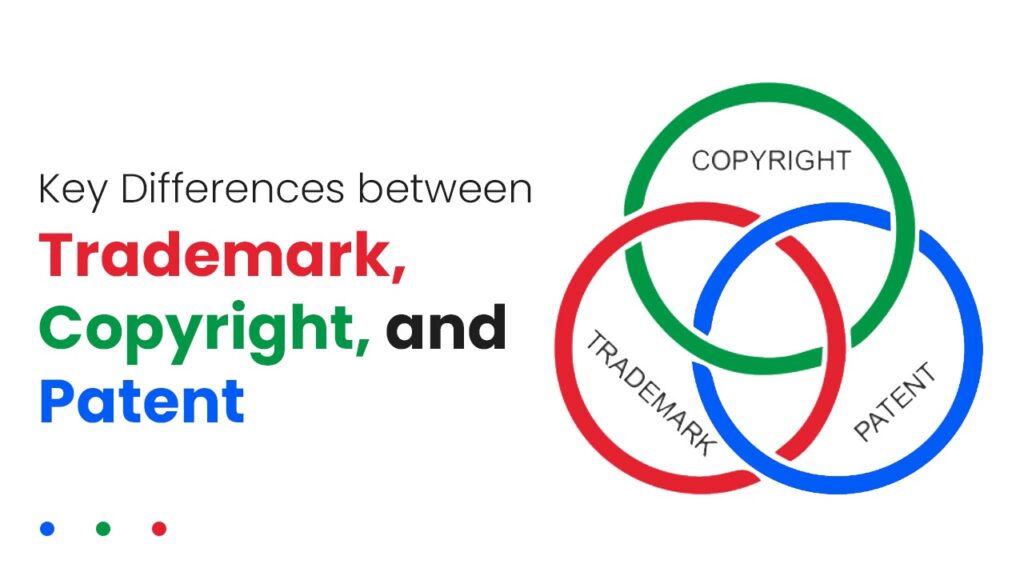Patent, trademark, and copyright: You perhaps hear these terms whenever a product enters the market. What exactly do they mean? Of course, all are related to protecting the product from being copied by others. They make sure the designed or invented product belongs to the original creator. And it’s one of the crucial steps for the products that just entered the market.
Although all of them seem pretty similar, each depicts distinct legal protection. If you’re curious to know the major differences, you’re in the right place. Read on.
Get An Insights On Patent
Patent rights usually protect innovations, inventions, or discoveries. For instance, if a person manufactures a novice health drug, their intellectual property receives a patent from the respective authorities in the country. Since the drug has its patent, it can now be produced in large masses and served to its target market.
In general, there are different types of patents— Utility, plant, and design.
- Utility Patents
A utility patent is simply the patent that’s given for the innovations. For instance, if a creator is improvising or creating a new product in the market, they get a utility patent to produce, market, sell, and use it without legal complications.
The problem with this patent is that it has a limited lifetime of up to 20 years. After that period, the creator must pay the maintenance fees per the rules and regulations. Utility patents are associated with appliances, machines, software products, drug formulations, etc.
- Plant Patents
Unlike utility patents, plant patents are applicable for new essential features of a plant. This patent prevents these key features from copycats who use them for their benefit. It’s also best for 20 years from the date of application filing. The plant is generally required to produce asexually using various techniques and processes such as grafting, root cuttings, division, etc.
- Design Patents
As this patent name suggests, it’s related to the design or appearance of a product. For instance, if a car company has designed headlights in a unique shape and design, they can garner the design patent to protect it from being copied.
Learn About Copyright Protection Law
Here comes the final one— Copyright. It’s used for protecting the original works of a person or a creator. These include writings, paintings, music, various arts, etc. If you’ve been in the online space for a while, you perhaps observed a few images on the internet that are protected by copyrights.
Usually, the copyright owner is only eligible to showcase, share, or publish the piece of work. Unlike other protection rights, you don’t need to apply to copyrights. As soon as your work is transformed into a tangible form, it gets copyrights.
In case you hire an employee to create the work under your scope, the copyrights will be issued for the piece of work as the company’s property. Moreover, intangible works, like choreographic work, topic ideation, story creativity, etc., will not be considered under copyright law. Furthermore, the calendar, charts on the internet, or other generic information isn’t protected by any copyright law.
In general, this law is helpful for publishing books, research journals, or other scientific copies by original creators. No other people are eligible to use their work. If anyone takes the copyrighted work, they will face a huge legal crisis in the future.
Let’s Understand Trademark
So far, you know that patents are used for innovative products. On the other hand, a trademark is best for shielding design elements or words that help the users identify a brand or product. The best examples include company logos and names.
For instance, if a company has created a delicious beverage and named it Pepsi will face severe legal complications as the brand name “Pepsi” has been protected and mustn’t be copied. This is commonly known as trademark infringement.
Trademark is one of the most complicated as it goes beyond copying names and designs. It’s linked to protecting the unique marks and preventing confusion in the design or word recognition.
That’s why you use distinct and interactive designs or words for your product or brand. The products or brands might face trademark infringement if it sounds or looks similar to the others. Moreover, the trademark holder has all the rights to dump you legally if they recognize trademark infringement of their brand or product.
Then, What About Trademark And Brand
Most people are often confused between a trademark and a brand. Beans is a marketing concept related to customers’ interaction with your services or products. For instance, few brands help you increase confidence while the other ensures to maintain peace and harmony.
On the other hand, a trademark is a legal protection law imposed on the services or products linked to the brand. And securing the brand’s products under trademark law is completely optional. For instance, some brands opt for trademarks while others might not be interested in them.
However, protecting your brand under the trademark law is highly secure and prevents it from becoming the victim of fraudulent activities. There are several cases where people misuse the most popular brand’s name and logos that aren’t protected legally. As a result, it’s difficult to find out the actual frauds misusing the brand or logo name.
Key Takeaways
Patent, trademark, and copyright are protection laws for products or services. Although all of them are intended to shield the original craftsmanship, each is used for a distinct purpose. For instance, patents are used for inventions or discoveries. At the same time, the trademark and copyrights protect the brand’s unique identities and artworks.
It’s an individual choice whether to apply for a legal protection law for their services or not. However, registering under these laws helps prevent your products from being misused by frauds or scammers. So, choose the suitable protection law based on your products.


